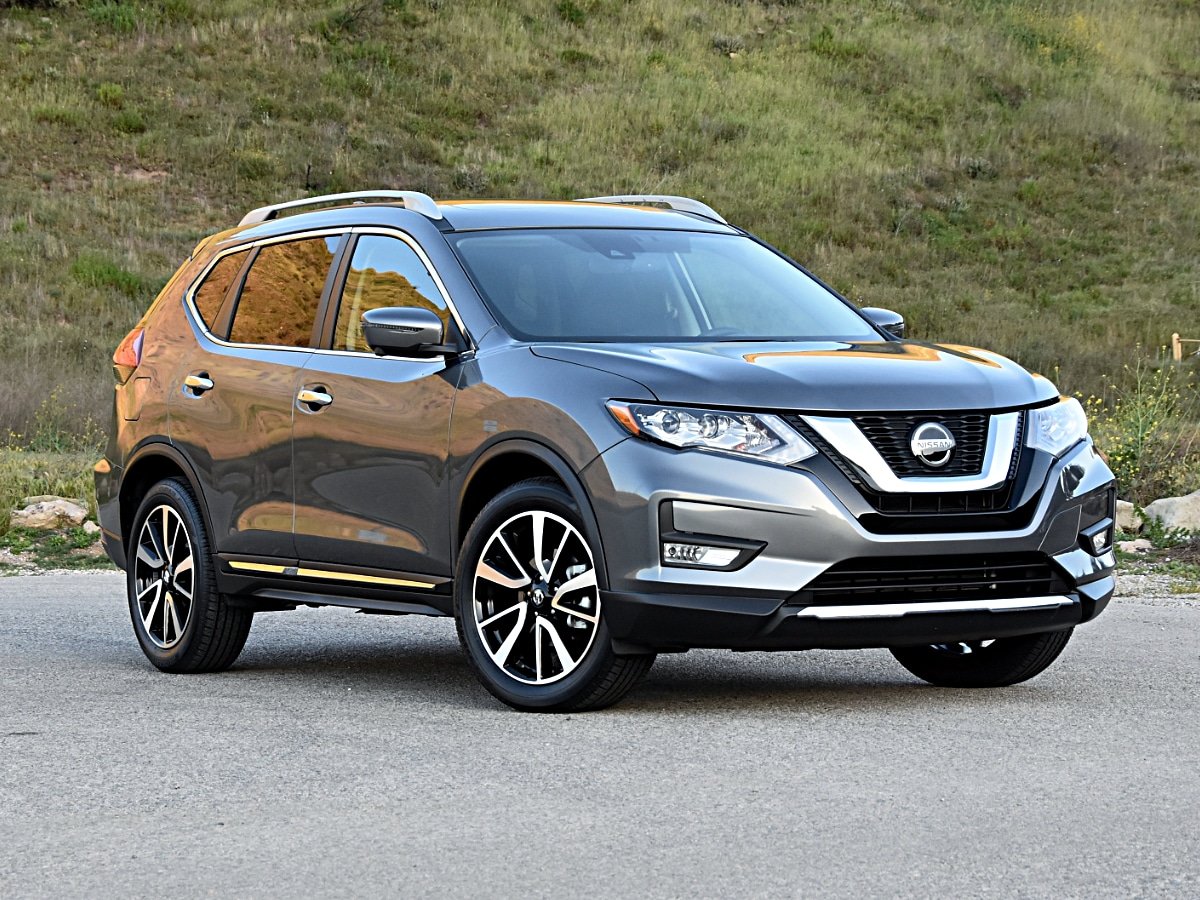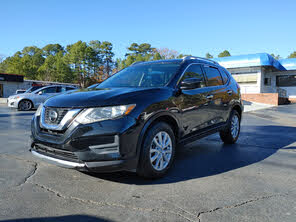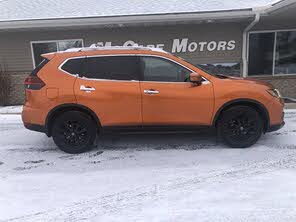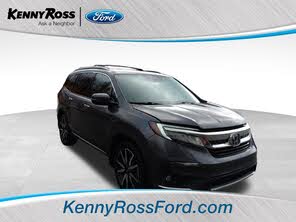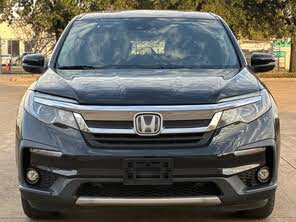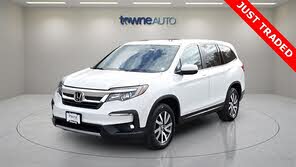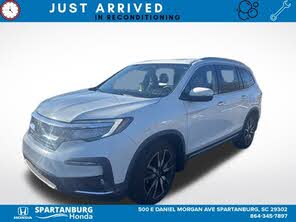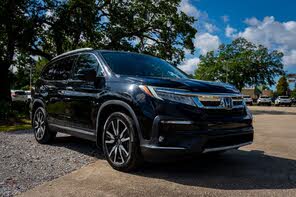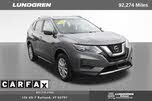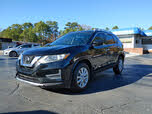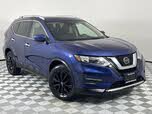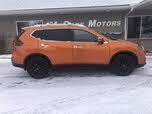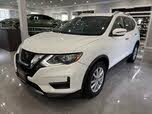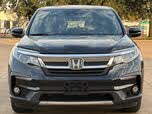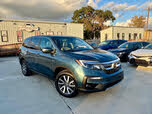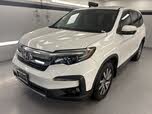2020 Nissan Rogue vs 2020 Honda Pilot
Overview | |
MSRP$25,490 | MSRP$31,650 |
Listings1138 | Listings653 |
Ratings & Reviews | |
User Reviews | User Reviews |
Expert reviews6.0 out of 10 | Expert reviews8.0 out of 10 |
Pros
Cons
| Pros
Cons
|
2020 Nissan Rogue Reviews SummaryNissan hasn’t redesigned the Rogue since 2014, but an all-new version of this SUV is coming for the 2021 model year. In the meantime, dealers will be eager to sell remaining stocks of the outgoing 2020 Nissan Rogue, and the deals on these new cars ought to be mighty juicy. Should you bite? Should you wait? Or should you shop for something else? The answers to these questions depend on who you are and what you value in a compact crossover SUV. | |
2020 Honda Pilot Reviews SummaryThe Honda Pilot was once the leader of the midsize 3-row SUV pack. But several rivals from Hyundai, Kia, and Mazda have caught up to (and in some cases, surpassed) the Pilot. Still, the Pilot offers tons of cargo space, an adult-friendly third row, and an impressive list of standard safety features. But Honda’s choices on driver controls and in-car tech are its biggest shortcomings. Read on to learn how the Pilot stacks up against the competition, and to learn the CarGurus recommended trim. | |
No video found | No video found |
Popular Features & Specs | |
Engine2.5L 170 hp I4 | Engine3.5L 280 hp V6 |
Drive TrainFWD | Drive TrainFWD |
Seating Capacity5 | Seating Capacity8 |
Horsepower170 hp @ 6000 rpm | Horsepower280 hp @ 6000 rpm |
MPG City26 | MPG City19 |
MPG Highway33 | MPG Highway27 |
Engine | |
Engine Name2.5L 170 hp I4 | Engine Name3.5L 280 hp V6 |
Torque175 lb-ft @ 4400 rpm | Torque262 lb-ft @ 4700 rpm |
Horsepower170 hp @ 6000 rpm | Horsepower280 hp @ 6000 rpm |
DrivetrainFWD | DrivetrainFWD |
Fuel Economy | |
MPG City26 | MPG City19 |
MPG Highway33 | MPG Highway27 |
Interior | |
Seating Capacity5 | Seating Capacity8 |
Safety | |
Front Crash Overall4 | Front Crash Overall4 |
Side Crash Overall5 | Side Crash Overall5 |
Dimensions & Capacity | |
Cargo Space39.3 cu ft | Cargo Space16.5 cu ft |
Curb Weight3463 lbs | Curb Weight4036 lbs |
Height66.3 in | Height70.6 in |
Length184.5 in | Length196.5 in |
Width72.4 in | Width78.6 in |
Wheelbase106.5 in | Wheelbase111.0 in |
Maximum Payload1127 lbs | Maximum Payload1509 lbs |
Number of doors4 | Number of doors4 |
Maximum Towing Capacity | Maximum Towing Capacity3500 lbs |
Overview | ||
MSRP | $25,490 | $31,650 |
Listings | ||
Ratings & Reviews | ||
User reviews | ||
Expert reviews | 6.0 out of 10Read full review | 8.0 out of 10Read full review |
Pros & cons | Pros
Cons
| Pros
Cons
|
Summary | Nissan hasn’t redesigned the Rogue since 2014, but an all-new version of this SUV is coming for the 2021 model year. In the meantime, dealers will be eager to sell remaining stocks of the outgoing 2020 Nissan Rogue, and the deals on these new cars ought to be mighty juicy. Should you bite? Should you wait? Or should you shop for something else? The answers to these questions depend on who you are and what you value in a compact crossover SUV. | The Honda Pilot was once the leader of the midsize 3-row SUV pack. But several rivals from Hyundai, Kia, and Mazda have caught up to (and in some cases, surpassed) the Pilot. Still, the Pilot offers tons of cargo space, an adult-friendly third row, and an impressive list of standard safety features. But Honda’s choices on driver controls and in-car tech are its biggest shortcomings. Read on to learn how the Pilot stacks up against the competition, and to learn the CarGurus recommended trim. |
Video | No video found | No video found |
Popular Features & Specs | ||
Engine | 2.5L 170 hp I4 | 3.5L 280 hp V6 |
Drive Train | FWD | FWD |
Seating Capacity | 5 | 8 |
Horsepower | 170 hp @ 6000 rpm | 280 hp @ 6000 rpm |
MPG City | 26 | 19 |
MPG Highway | 33 | 27 |
Engine | ||
Engine Name | 2.5L 170 hp I4 | 3.5L 280 hp V6 |
Torque | 175 lb-ft @ 4400 rpm | 262 lb-ft @ 4700 rpm |
Horsepower | 170 hp @ 6000 rpm | 280 hp @ 6000 rpm |
Drivetrain | FWD | FWD |
Fuel Economy | ||
MPG City | 26 | 19 |
MPG Highway | 33 | 27 |
Interior | ||
Seating Capacity | 5 | 8 |
Safety | ||
Front Crash Overall | 4 | 4 |
Side Crash Overall | 5 | 5 |
Dimensions & Capacity | ||
Cargo Space | 39.3 cu ft | 16.5 cu ft |
Curb Weight | 3463 lbs | 4036 lbs |
Height | 66.3 in | 70.6 in |
Length | 184.5 in | 196.5 in |
Width | 72.4 in | 78.6 in |
Wheelbase | 106.5 in | 111.0 in |
Maximum Payload | 1127 lbs | 1509 lbs |
Number of doors | 4 | 4 |
Maximum Towing Capacity | 3500 lbs | |
The 2020 Nissan Rogue offered simplicity with its available trims—S, SV, and SL—all equipped with a single engine and transmission combination, along with a choice of front-wheel drive (FWD) or all-wheel drive (AWD). Our review focused on the SL trim with front-drive, including the SL Premium Package, carpeted floor and cargo mats, and a first-aid kit, summing up to a window sticker price of $34,870 (including destination charge).
Despite its age, the Rogue maintained an attractive appearance. Its prominent V-Motion grille and exaggerated fender swells were noticeable, but when combined with SL’s 19-inch aluminum wheels, it still appeared appealing. However, opening the door revealed the Rogue's outdated interior. The waterfall control panel and rounded surfaces seemed dated in contrast to the modern design trends emphasizing wide, horizontal, and angular motifs. The plastic surfaces inside were also underwhelming.
Nonetheless, the Rogue SL had a thoughtful touch with padded sides on the center console where the driver’s legs might rest, enhancing comfort during driving.
Conversely, the 2020 Honda Pilot exhibited dynamic styling in sync with the rest of Honda’s lineup. It featured thin LED headlights and a multi-tiered grille, while an uptick in the belt-line around the rear side windows cleverly masked its substantial size, making it appear more streamlined.
Inside, the Pilot offered a modern cabin with a semi-digital instrument panel. The fuel and engine-temperature gauges were analog, but other information was shown on a digital screen in front of the driver. The cabin felt spacious and comfortable with a solid level of refinement, though hard plastics were present, giving a lesser feel compared to rivals like the Kia Telluride, Hyundai Palisade, and Mazda CX-9.
The Honda Pilot came in various trims: LX, EX, EX-L, Touring, Elite, and Black Edition, each offering a range of features. Notable among them, the EX trim added advanced conveniences such as remote start, Apple CarPlay, Android Auto, LED fog lights, Smart Entry, tri-zone climate control, and heated front seats, making it a recommended choice by CarGurus.




Nissan equipped the 2020 Rogue with a single engine—a 170-horsepower 2.5-liter four-cylinder paired with a continuously variable automatic transmission (CVT). Although the CVT tried to make the most of it, the Rogue’s performance was only adequate for a vehicle weighing up to 3,671 pounds. Despite a Sport driving mode, it lacked sportiness. During acceleration, passing maneuvers, mountain grades, or attempting quick turns, the Rogue often responded with noise rather than action, leading to disappointment.
Fuel efficiency also left more to be desired. Despite the Environmental Protection Agency (EPA) suggesting a combined 29 mpg for the FWD version, testing yielded no better than 24.9 mpg, even with plenty of freeway driving.
Dynamically, the Rogue benefited from Intelligent Trace Control and Active Ride Control, brake-induced technologies aimed at enhancing ride and handling. Intelligent Trace Control worked like a torque-vectoring system to tighten turns, while Active Ride Control aimed to smooth out bumps and undulations. These features worked as claimed, but with heavy and lifeless electrically assisted steering, poor suspension isolation, and occasional CVT drone, driving the Rogue SL wasn’t an enjoyable experience.
In contrast, the 2020 Honda Pilot was powered by a robust 3.5-liter V6 engine generating 280 horsepower and 262 pound-feet of torque, directed to either the front wheels or available all-wheel drive. Base trims (LX, EX, EX-L) featured a 6-speed automatic transmission, while the higher trims (Touring, Elite, Black Edition) included a refined 9-speed automatic transmission, enhancing acceleration and potentially improving fuel economy.
Honda’s choice to replace a conventional shifter with a proprietary button setup posed learning curve challenges and practical annoyances, requiring drivers to look at the instrument panel or release the brake to confirm gear selection, adding an unnecessary layer of complexity.
Despite this, the Pilot’s V6 engine provided strong acceleration, easily tackling standstill starts or highway passing maneuvers with ease. Its ride quality was finely tuned for real-world driving, ensuring a comfortable and refined experience, albeit lacking in athleticism—a trait unlikely sought in a three-row SUV. Additionally, Honda featured an Intelligent Traction Management System with selectable modes for Normal, Snow, Mud, and Sand, accommodating various driving conditions.
The 2020 Nissan Rogue's interior comfort was compromised for larger drivers. Although the seats were derived from Nissan's excellent Zero Gravity designs aiming for perfect support, their undersized nature resulted in difficulty finding a comfortable seating position, particularly for those with longer legs or heavier frames. The lack of adjustable height in the driver's seat left taller drivers with cramped leg space under the steering wheel.
Conversely, passengers in the backseat fared much better with high, stadium-style seating, excellent thigh support, proper backrest angles, and a great view enhanced by the panoramic glass sunroof. Amenities like rear air conditioning vents and USB charging ports contributed to a pleasant experience for rear-seat occupants.
However, storage space within the cabin was limited, with the glove compartment offering the only significant stowage. On the flip side, the Rogue excelled in cargo capacity, offering a generous 39 cubic feet behind the back seat, significantly surpassing rivals like the Mazda CX-5. The Rogue also included underfloor storage compartments and the standard Divide-n-Hide cargo management system.
Shifting to the 2020 Honda Pilot, this SUV offered exceptional space for up to eight passengers when equipped with second-row bench seating, or seven with second-row captain’s chairs in the upper trims (Touring, Elite, Black Edition). Unlike many competitors, the Pilot's third row was genuinely adult-friendly, and the EX trims and higher featured one-touch fold-down rear seats, simplifying access to the third row.
In terms of cargo capacity, with second and third rows folded, the Pilot provided 83.9 cubic feet, falling slightly short compared to competitors like the Kia Telluride (87 cu. ft.), Hyundai Palisade (86.4 cu. ft.), Subaru Ascent (86.5 cu. ft.), and Volkswagen Atlas (96.8 cu. ft.), but still exceeding the Mazda CX-9 with its 71.2 cubic feet. The Pilot also featured a power liftgate in EX-L and higher trims, with hands-free operation on Touring and above.
The Pilot's cabin was family-friendly, designed with numerous storage spaces for essentials like toys and juice boxes. The second-row captain’s chairs offered additional convenience by providing a clear passage to the third row. The conversation mirror, a handy feature for parents, allowed for surveillance over the rear passengers.
The 2020 Nissan Rogue boasted an impressive array of infotainment features on paper, including Bluetooth connectivity, Apple CarPlay, Android Auto, and a hands-free text messaging assistant as standard. Depending on the trim level, upgrades included SiriusXM satellite radio, navigation with smartphone-based door-to-door assistance, a Bose premium sound system, and NissanConnect Services.
NissanConnect Services offered numerous subscription-based features like Amazon Alexa, Google Assistant, remote engine start and door lock operation, car finder function, automatic collision notification, emergency SOS calling, and teen driver settings for speed, curfew, and geographic boundaries. However, the Rogue’s NissanConnect interface itself was subpar, with a dated 7-inch touchscreen, slow response times, and unreliable voice recognition, culminating in a frustrating user experience.
In contrast, the 2020 Honda Pilot provided a mixed bag of technology. The LX base trim was equipped with a 5-inch color LCD screen and a basic 215-watt, 7-speaker stereo. Higher trims upgraded to an 8-inch Display Audio touchscreen infotainment system with Apple CarPlay and Android Auto.
However, Honda’s Display Audio system was overcomplicated, featuring a small volume knob without an actual tuning knob, necessitating touchscreen interaction for radio operation. The layout and user experience of the system were confusing and seemed either overly complex or insufficiently considered.
Higher trims of the Pilot included additional features like HD Radio, SiriusXM satellite radio, and a Cabin Control Remote Capability, allowing rear-seat passengers to control the stereo via a smartphone app. Advanced options included navigation, a rear-seat entertainment system, a wall-style power outlet, and an upgraded 590-watt, 10-speaker premium audio system in the higher trims. The Elite and Black Edition further added a wireless charging pad.
The 2020 Nissan Rogue came with the Safety Shield 360 suite as standard, bundling together forward-collision warning with pedestrian detection, automatic emergency braking (front and rear), blind-spot monitoring, rear cross-traffic alert, lane departure warning, and automatic high beams. These features made the Rogue's ADAS offerings effective and user-friendly, surpassing many competitors.
Additional safety features included Rear Door Alert and a Tire Fill Alert system, with optional upgrades like a surround-view camera and ProPilot Assist adaptive cruise control with lane-centering. Despite these features, the Rogue's age was evident in its crash-test ratings. The National Highway Traffic Safety Administration (NHTSA) awarded it an overall 4-star rating, weakened by a 3-star driver protection score in a frontal impact. The Insurance Institute for Highway Safety (IIHS) also gave it lower marks for headlights and front-passenger protection, precluding it from earning a Top Safety Pick.
The 2020 Honda Pilot, on the other hand, featured the comprehensive HondaSensing suite as standard across all trims. This included forward-collision avoidance, automatic emergency braking, lane-departure warning, adaptive cruise control, and automatic high beams.
The Pilot also came equipped with standard front and side-impact airbags, child-seat anchors, Vehicle Stability Assist, and traction control. Optional safety features included front and rear parking sensors and blind-spot monitoring with rear cross-traffic alert.
The Honda Pilot earned the highest safety ratings, achieving a five-star overall crash test rating from the NHTSA and a top score of Good from the IIHS. Additionally, it received the Superior rating in IIHS crash prevention technology evaluation thanks to HondaSensing.
CarGurus highlights
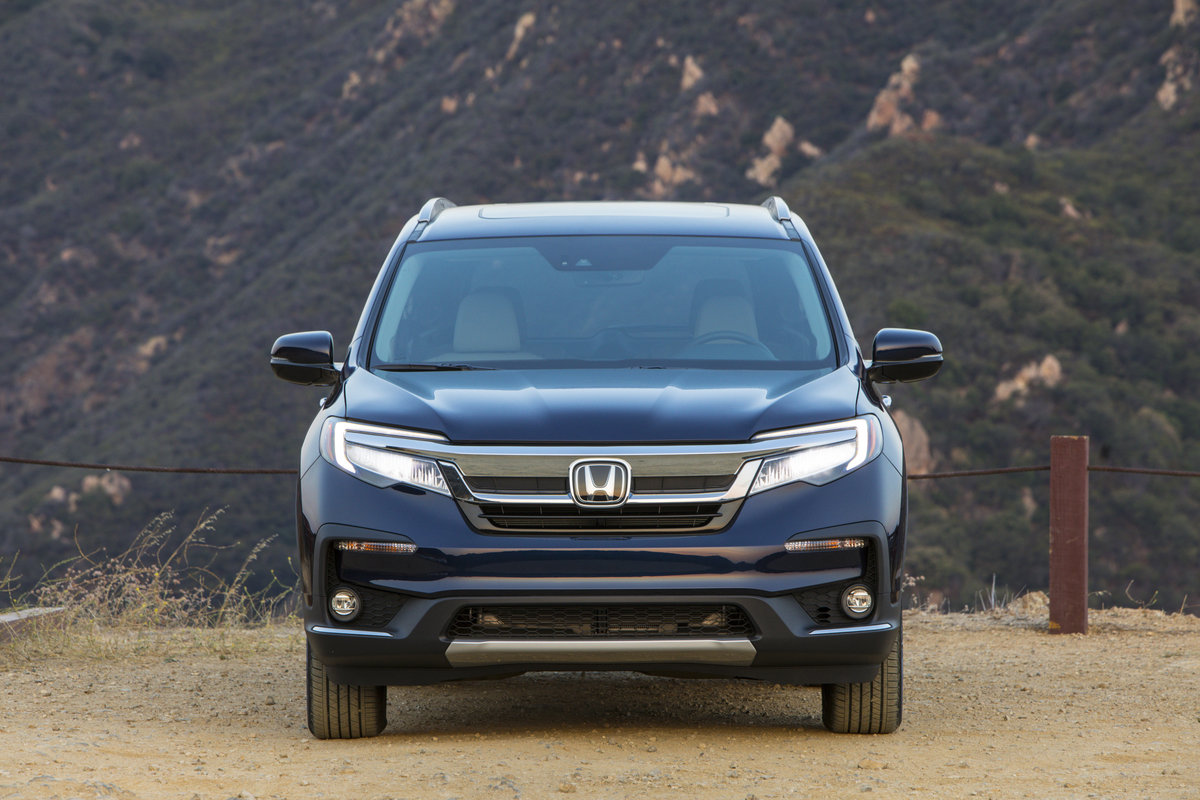
According to CarGurus experts, the overall rating for the 2020 Nissan Rogue was 6.0 out of 10, while the 2020 Honda Pilot scored 8.0 out of 10. With a higher rating, better safety credentials, and superior overall performance, the 2020 Honda Pilot emerges as the stronger choice for consumers looking for a reliable and feature-packed SUV. While the Rogue offers an attractive design and ample rear cargo space, the Pilot’s advanced safety features, spacious interior, and robust powertrain make it a more compelling option for most drivers.
Choose the 2020 Nissan Rogue if:
- You prefer a compact SUV with a standout exterior design.
- Ample rear-seat passenger comfort and a panoramic sunroof are priorities.
- Cargo space with underfloor storage and the Divide-n-Hide system is essential.
Choose the 2020 Honda Pilot if:
- You need a three-row SUV with spacious, adult-friendly third-row seating.
- Superior safety ratings and a comprehensive suite of driver assistance features are important to you.
- Modern interior with advanced technology and infotainment options is what you are looking for.
CarGurus highlights

According to CarGurus experts, the overall rating for the 2020 Nissan Rogue was 6.0 out of 10, while the 2020 Honda Pilot scored 8.0 out of 10. With a higher rating, better safety credentials, and superior overall performance, the 2020 Honda Pilot emerges as the stronger choice for consumers looking for a reliable and feature-packed SUV. While the Rogue offers an attractive design and ample rear cargo space, the Pilot’s advanced safety features, spacious interior, and robust powertrain make it a more compelling option for most drivers.
Choose the 2020 Nissan Rogue if:
Shop Now- You prefer a compact SUV with a standout exterior design.
- Ample rear-seat passenger comfort and a panoramic sunroof are priorities.
- Cargo space with underfloor storage and the Divide-n-Hide system is essential.
Choose the 2020 Honda Pilot if:
Shop Now- You need a three-row SUV with spacious, adult-friendly third-row seating.
- Superior safety ratings and a comprehensive suite of driver assistance features are important to you.
- Modern interior with advanced technology and infotainment options is what you are looking for.

By: CarGurus + AI
At CarGurus, our team of experienced automotive writers remain at the heart of our content operation, conducting hands-on car tests and writing insightful guides that are backed by years of industry experience. To complement this, we are harnessing AI to make our content offering more diverse and more helpful to shoppers than ever. To achieve this, our AI systems are based exclusively on CarGurus content, ratings and data, so that what we produce is both unique to CarGurus, and uniquely helpful to car shoppers.
